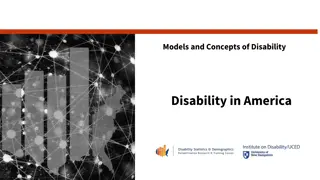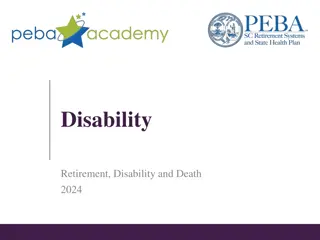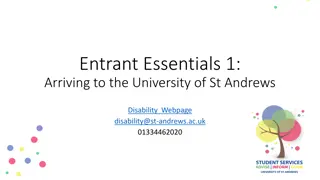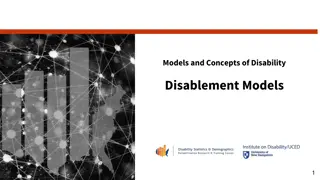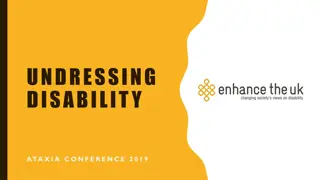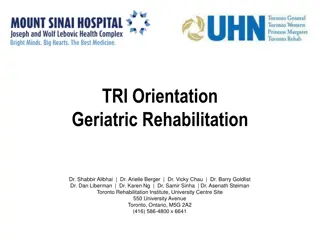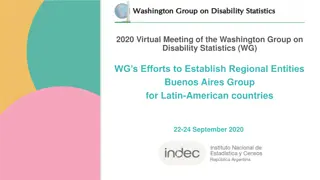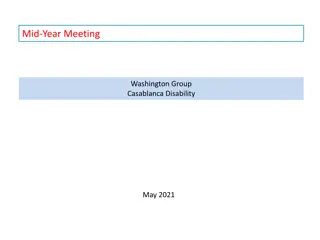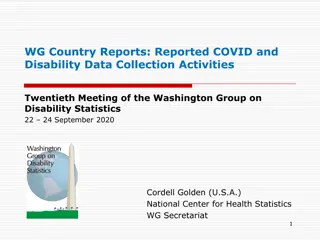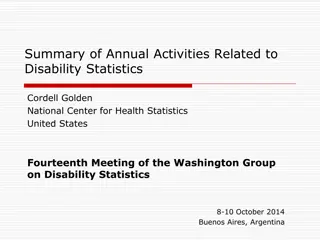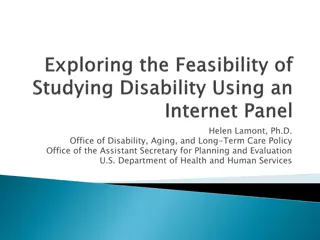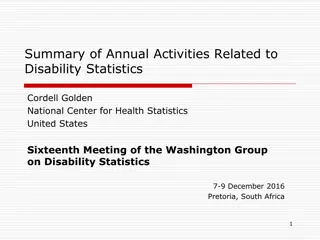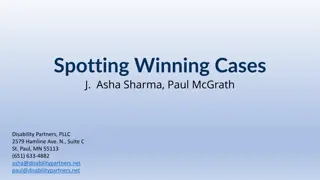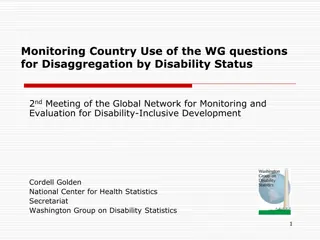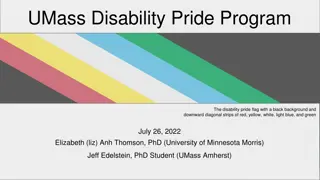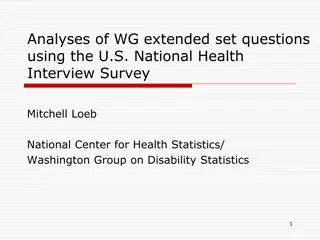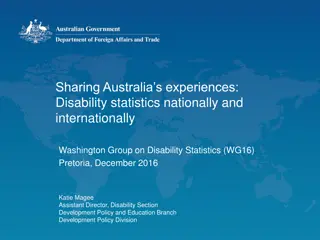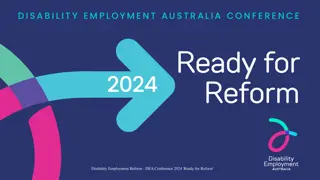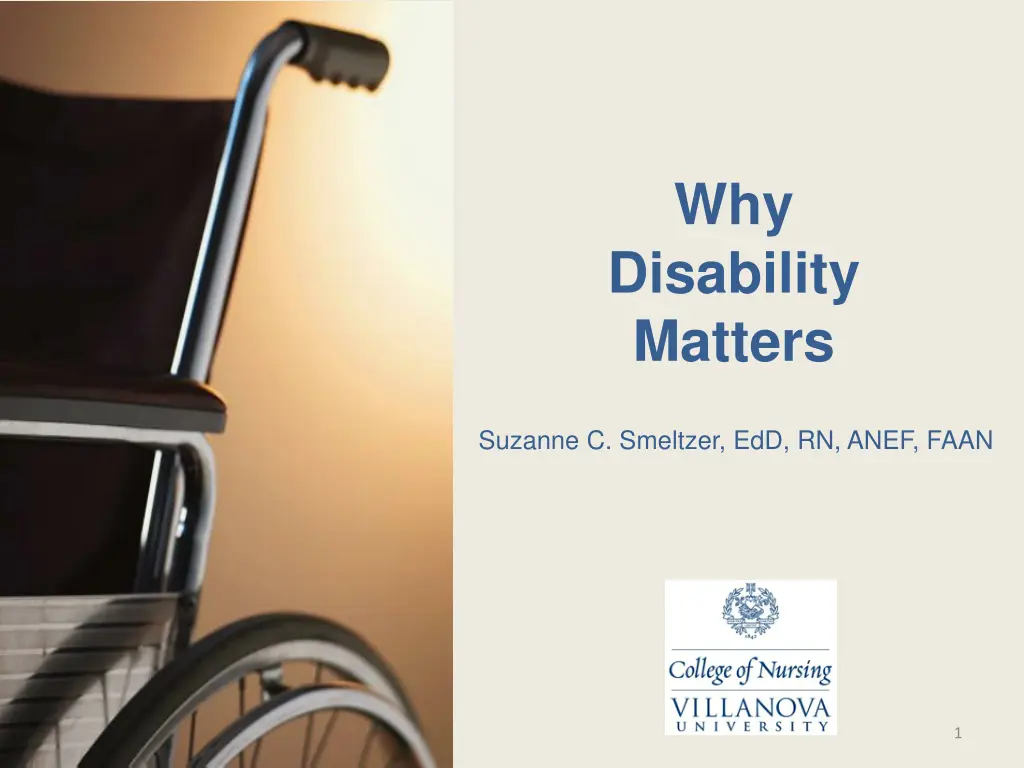
Understanding Disability in Nursing Education
Explore the importance of integrating disability content in nursing education, learn about the prevalence of disabilities, definitions according to ADA and WHO, and the role of nursing professionals in caring for individuals with disabilities.
Uploaded on | 2 Views
Download Presentation

Please find below an Image/Link to download the presentation.
The content on the website is provided AS IS for your information and personal use only. It may not be sold, licensed, or shared on other websites without obtaining consent from the author. If you encounter any issues during the download, it is possible that the publisher has removed the file from their server.
You are allowed to download the files provided on this website for personal or commercial use, subject to the condition that they are used lawfully. All files are the property of their respective owners.
The content on the website is provided AS IS for your information and personal use only. It may not be sold, licensed, or shared on other websites without obtaining consent from the author.
E N D
Presentation Transcript
Why Disability Matters Suzanne C. Smeltzer, EdD, RN, ANEF, FAAN 1
Learning Objectives 1) Identify the rationale for integration of disability content/concepts in nursing education, 2) Describe the factors leading to the increasing population of persons with disability, 3) Define disability and identify the major categories of disability, 4) Discuss models of disability that are empowering to persons with disability and those that are disempowering to people with disability.
Learning Objectivescontinued 5) Identify key research findings related to the quality of health care of persons with disability. 6) Identify two federal agencies and professional organizations that have called for health care professions educators to improve the knowledge, skills and attitudes of health care professionals about caring for persons with disability. 7) Describe the role of the nursing profession and nursing education in the care of patients with disability
Prevalence of Disabilities ~ 60 million people in the U.S. and 1 billion worldwide live with one or more disabilities One in every 4 or 5 people (20% - 25%) lives with one or more disabilities Disability occurs across the life span 13.9% of children 11.0% of 18 - 44 year olds 23.9% of 45 - 64 year olds 51.8% of those > 65 years 44.8% of 65-74 year olds 63.7% of 75-84 year olds 84.2% for frail elderly
Disability Defined ADA s Definition of Disability: A physical or mental impairment that substantially limits one or more major life activities; a record or history of such an impairment; or is regarded/perceived by others as having such an impairment The American with Disabilities Act of 1990 https://www.ada.gov/law-and-regs/ 5
Disability Defined WHO s Definition of Disability Disability - an umbrella term for impairments, activity limitations or participation restrictions Focus moved away from consequence of disease to one on health and factors that affect health A person s functioning / disability is a dynamic interaction between health conditions (diseases, disorders, injuries, etc.) and contextual factors (personal and environmental factors) that affect health. 6 WHO (2000). International classification of functioning, disability and health. WHO: Geneva.
International Council of Nurses (ICN) Disability: a physical, mental, sensory, or social Impairment that, in the long term, adversely affects one s ability to carry out normal day-to-day activities ICN supports programs designed to integrate PWD in all aspects of daily life --- in the family, school, workplace and community ICN position statement: Prevention of disability and the care of people with disabilities (2000, revised 2010)
International Council of Nurses (ICN) ICN position statement: nurses are expected to have an understanding of the particular problems faced by PWD and their families and to have advocacy skills and a knowledge of programs and resources in the community nurses are expected to assist, support and advocate for PWD and their families to access education, information and support services that allow them to lead fulfilling lives
Another View of Disability Disability is a universal experience that affects nearly everyone without exception at sometime in their lives. Kirschner & Curry (2009) Kirschner, K. & Curry, R. (2009). Educating health care professionals to care for patients with Disabilities. Journal of the American Medical Association, 302(12), 1334-1335. 9
Significance of Definitions and Views of Disability Determine our views and perceptions of and attitudes toward people with disabilities (PWD) Influence how we treat and interact with PWD in all education, clinical practice, and community sites and settings Serve as a check on our attitudes and values about PWD Influence how we teach others about disability Determine eligibility of persons with disabilities (PWDs) for services and what services are allowed and what is mandated by law 10
Characteristics of Disabilities Disabilities vary in severity: Very mild [inconvenient] Moderate [interfere with some activities] Severe [assistance needed for IADLs, ADLs] Very severe [technology needed for survival] Disabilities vary in type Physical impairment Visual and hearing impairment Psychiatric/mental health disabilities Cognitive/intellectual and developmental disabilities Communication disabilities Combinations of any or all of above 11
Characteristics of Disabilities Disabilities vary in visibility Not visible at all to others Visible to informed others Visible to all Disabilities are seen across all settings Hospital, clinics, OB/Gyn offices, pediatric settings, community settings, schools, independent living centers and group homes, home care, long-term care facilities, nursing homes 12
Characteristics of Disabilities Population of people with disability is increasing in size Advances in health care and survival of people with disabilities across the lifespan: VLBW babies, those with pre-existing disabilities, chronically critically ill children and adults Increased numbers of people with chronic disease Increased number of elderly and frail elderly Increased survival of those with trauma For all those killed in mass shootings, bombings, natural catastrophes, many more are disabled 13
Common Research Findings Across Disciplines: PWD receive less health care and care that is of lower quality than those without disabilities PWD have reported being refused health care PWD have a thinner margin of safety/health than those without disability Health care sites (imaging centers, offices, etc.) continue to be inaccessible despite the ADA (many PWD have not been weighed in years because of lack of appropriate weight scales) Negative attitudes toward PWD among health care professionals persist and result in negative encounters with HCPs. 14
Common Research Findings Across Disciplines: PWD have reported being refused health care PWD have a thinner margin of safety/health than those without disability Health care sites (imaging centers, offices, etc.) continue to be inaccessible despite the ADA Negative attitudes toward PWD among health care professionals persist and result in negative encounters with HCPs. 15
Consequences of Negative Encounters of PWDs with Health Care Providers People with disabilities may avoid health care providers unless and until absolutely necessary Inadequate health care, including preventive screening Delay in treatment or lack of treatment Low level of participation in health promotion activities Poor health status, isolation, psychological issues 16
Concerns about the quality of health care of people with disabilities Study of Nursing Care Experiences of People with Disabilities During Hospitalization Qualitative study via 6 focus groups of community- residing people with disabilities with hospital experience 35 people with diverse disabilities across spectrum of severity from mild to very severe
Four themes emerged from analysis of data: Poor Communication Nursing staff ignore people with disability and talk/listen instead to others (family, friends, others) anyone but them PWD needed to explain and re-explain to nursing staff what works and what doesn t work for them; treated as if they knew nothing about their own disabilities PWD recommended that communication skills be part of the curriculum, especially with people with disabilities Compromised Care Disabilities not taken into account during care due to inadequate knowledge; care not individualized Lack of caring, compassion, understanding, patience and respect toward PWD
Four Themes Negative Attitudes Seen as low priority, marginalized and seen as burden by nursing staff Feared, ignored and on occasion abused Treated as children, as asexual and uninterested in childbearing Fear about Hospitalization Sense of vulnerability; lack of control over well-being and fear of being hurt while hospitalized Fear of being left without assistive devices based on previous experiences Fear of leaving the hospital in worse shape than when admitted
Calls for Addressing Disability in Health Care Professions Education Two U.S. Surgeon General reports (2002, 2005) One Institute of Medicine Report (2007) One National Council on Disability Report (2009) One WHO World Report on Disability One Affordable Care Act provision (2010) All have called for strategies to improve knowledge, skills and attitudes of HCPs to, in turn, improve the health care of persons with disabilities. Generally health care professional educators have not responded adequately to these calls for action. 20
Summary of Findings of 3 Studies: Disability is largely invisible at both undergraduate and graduate level nursing programs and in textbooks Some faculty report teaching about it; their responses suggest otherwise Faculty report that more important content would have to be deleted AND disability is not a very important issue Students are not tested on it; therefore, it is not taught Some faculty admitted that they never thought about it participating in study 21
Another View of Disability Disability is a universal experience that affects nearly everyone without exception at sometime in their lives. Kirschner & Curry (2009) Kirschner, K. & Curry, R. (2009). Educating health care professionals to care for patients with Disabilities. Journal of the American Medical Association, 302(12), 1334-1335. 22
References Goodall, C.J. (1995). Is disability any business of nurse education? Nurse Education Today. 15(5):323-7. Kirschner, K. & Curry, R. (2009). Educating health care professionals to care for patients with Disabilities. Journal of the American Medical Association, 302(12), 1334-1335. Lam, W. Y. Gunukula, S. K., McGuigan, D., Isaiah, N., Symons, A. B. & Akl, E. A. (2010). Validated instruments used to measure attitudes of healthcare students and professionals towards patients with physical disability: a systematic review. Journal of Neuroengineering Rehabilitation. 7: 55. Smeltzer, S. C. & Bare, B.S. (2010). Brunner & Suddarth's textbook of medical-surgical nursing. Philadelphia: Wolters Kluwer Health/Lippincott Williams & Wilkins, Chapter 10 Smeltzer, S. C., Dolen, M. A., Robinson-Smith, G. & Zimmerman, V. (2005). Integration of disability-related content in nursing curricula. Nursing Education Perspectives. 26(4), 210-216. Smeltzer, S. C., Robinson-Smith, F., Dolen, M. A., Duffin, J. & Al-Maqbali, M. (2010). Disability-related content in nursing textbooks. Nursing Education Perspectives. 31(3), 148-155. Smeltzer, S. C., Avery, C. & Haynor, P. (2012). Interactions of people with disabilities with nursing staff during hospitalization. American Journal of Nursing, 112 (4), 30-37. DOI:10.1097/01.NAJ.0000413454.07369.e3 23

